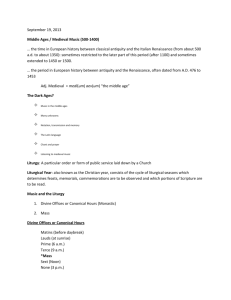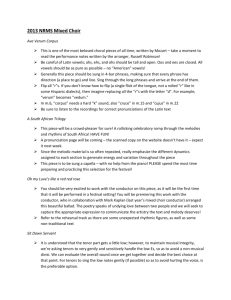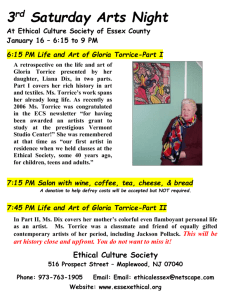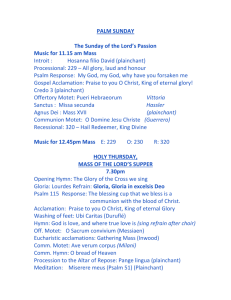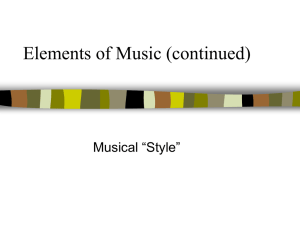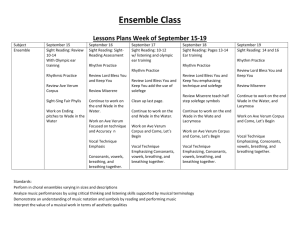Word document
advertisement
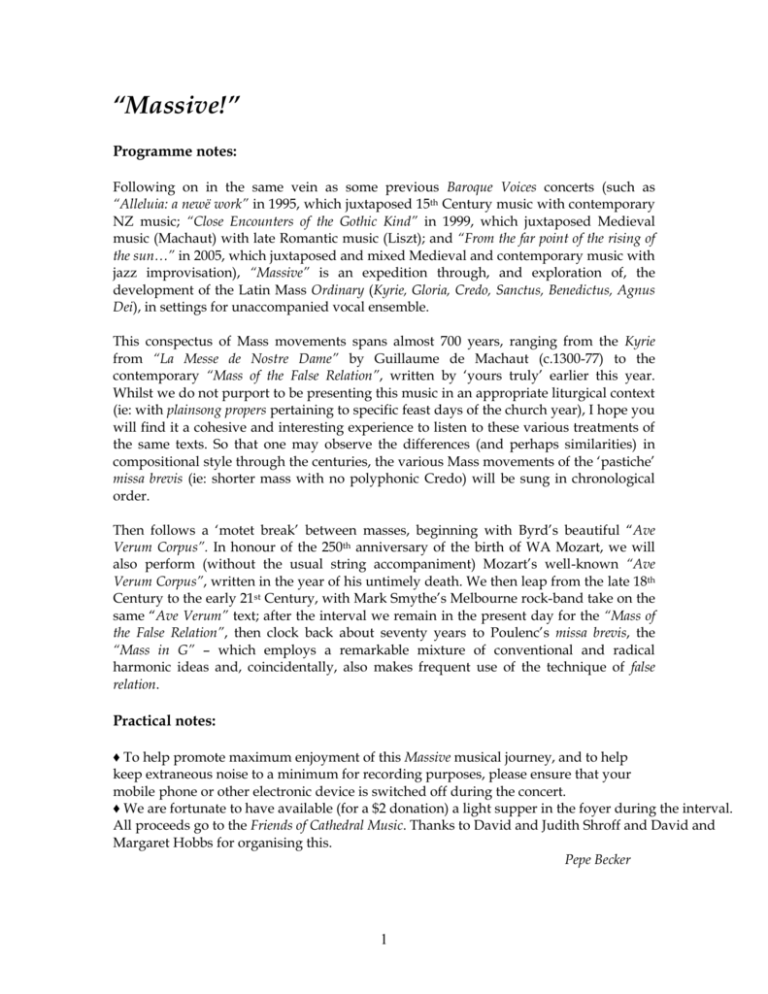
“Massive!” Programme notes: Following on in the same vein as some previous Baroque Voices concerts (such as “Alleluia: a newë work” in 1995, which juxtaposed 15th Century music with contemporary NZ music; “Close Encounters of the Gothic Kind” in 1999, which juxtaposed Medieval music (Machaut) with late Romantic music (Liszt); and “From the far point of the rising of the sun…” in 2005, which juxtaposed and mixed Medieval and contemporary music with jazz improvisation), “Massive” is an expedition through, and exploration of, the development of the Latin Mass Ordinary (Kyrie, Gloria, Credo, Sanctus, Benedictus, Agnus Dei), in settings for unaccompanied vocal ensemble. This conspectus of Mass movements spans almost 700 years, ranging from the Kyrie from “La Messe de Nostre Dame” by Guillaume de Machaut (c.1300-77) to the contemporary “Mass of the False Relation”, written by ‘yours truly’ earlier this year. Whilst we do not purport to be presenting this music in an appropriate liturgical context (ie: with plainsong propers pertaining to specific feast days of the church year), I hope you will find it a cohesive and interesting experience to listen to these various treatments of the same texts. So that one may observe the differences (and perhaps similarities) in compositional style through the centuries, the various Mass movements of the ‘pastiche’ missa brevis (ie: shorter mass with no polyphonic Credo) will be sung in chronological order. Then follows a ‘motet break’ between masses, beginning with Byrd’s beautiful “Ave Verum Corpus”. In honour of the 250th anniversary of the birth of WA Mozart, we will also perform (without the usual string accompaniment) Mozart’s well-known “Ave Verum Corpus”, written in the year of his untimely death. We then leap from the late 18th Century to the early 21st Century, with Mark Smythe’s Melbourne rock-band take on the same “Ave Verum” text; after the interval we remain in the present day for the “Mass of the False Relation”, then clock back about seventy years to Poulenc’s missa brevis, the “Mass in G” – which employs a remarkable mixture of conventional and radical harmonic ideas and, coincidentally, also makes frequent use of the technique of false relation. Practical notes: ♦ To help promote maximum enjoyment of this Massive musical journey, and to help keep extraneous noise to a minimum for recording purposes, please ensure that your mobile phone or other electronic device is switched off during the concert. ♦ We are fortunate to have available (for a $2 donation) a light supper in the foyer during the interval. All proceeds go to the Friends of Cathedral Music. Thanks to David and Judith Shroff and David and Margaret Hobbs for organising this. Pepe Becker 1 Programme: Kyrie – Guillaume de Machaut, c.1300-77 Gloria – Pennard ?, English, c.1390 Sanctus - Josquin des Prez, c.1450-1521 Benedictus – William Byrd, 1543-1623 Agnus Dei – Alessandro Scarlatti, 1660-1725 Motet: Ave Verum Corpus – William Byrd, 1543-1623 Motet: Ave Verum Corpus - WA Mozart, 1756-91 Motet: Ave Verum Corpus – Mark Smythe, b.1972 (2006) ~ 10 minute Interval (supper available in the foyer) ~ Introit: Come to Christ – Pepe Becker, b. 1966 (2001) Mass of the False Relation – Pepe Becker (2006) Kyrie, Gloria, Credo, Sanctus, Benedictus, Agnus Dei Messe en sol majeur – Francis Poulenc, 1899-1963 (1937) Kyrie, Gloria, Sanctus, Benedictus, Agnus Dei sibling composers Mark Smythe & Pepe Becker 2 ♦ Kyrie from La Messe de Nostre Dame – Guillaume de Machaut, c1300-77 Machaut so dominates his time as to eclipse many of his contemporaries, and seems to encapsulate in himself almost a whole century of musical development and innovation. His “Mass of Our Lady” is one of the earliest, probably the earliest, setting of the entire Ordinary of the mass by one single composer – previous settings consisted of several pieces of unequal quality and origin, all grouped together within the context of the Mass and often named after the location where they were assembled or performed, eg: the “Toulouse” or “Tournai” masses. A canon of Reims Cathedral, Machaut presented La Messe de Nostre Dame to the cathedral as a votive mass in honour of the Virgin. It seems to have been his intention that after his death it would become a memorial mass for himself and his brother Jean (also a canon of the cathedral) – both brothers were buried near the altar, and the mass presumably continued to be sung over them for many years. The Gloria and Credo sections of this mass are written without the liturgical cantus firmus (long notes derived from plainchant, usually in the tenor part, around which the other polyphonic voice-parts weave), and are in the style of the equal-voiced polyphonic conductus. The other four movements, including the Kyrie, use the technique of the motet, except that, unlike the traditional motettus style, all the voice parts have the same text. Another device which Machaut uses here (as in many of his secular works) is the hocket, a mode of writing in which melodic lines are fragmented between two or more voice parts, giving the effect of notes or clusters of notes being ‘thrown’ from one part to another, creating a marked contrast to the otherwise fluid polyphonic density. Kyrie eleison; Christe eleison; Kyrie eleison; Lord, have mercy; Christ, have mercy; Lord, have mercy. ♦ Gloria – Pennard? (c.1390) English composer Pennard’s only known work is a four-part setting of the Credo, ascribed to him in an thology called the Old Hall Manuscript, compiled between about 1415 and 1421 and kept (until 1973) at the college of St Edmund, Old Hall, near Ware, Hertfordshire. This Gloria, actually from another source known as the Fountains Fragment, has been attributed (by one MF Bukofzer) to Pennard, on the grounds that it is stylistically very similar to his Credo and that both movements have a cantus firmus taken from Trinity Sunday antiphon verses. It is a classic example of isorhythmic writing, with rhythmic fragments of the cantus firmus repeated throughout in the tenor and contratenor parts – which are textless and possibly would have been played on instruments as well as or instead of being sung. As often occurs with isorhythm, note values are halved in the latter repetitions of the plainchant cantus firmi. Gloria in excelsis deo Et in terra pax Hominibus bone voluntatis. Laudamus te, benedicimus te, adoramus te, glorificamus te, Gratias agimus tibi Propter magnam gloriam tuam. Glory to God on high And in earth peace, Good will towards men. We praise you, we bless you, we worship you, we glorify you, We give thanks to you For your great glory. 3 Domine deus, rex celestis, Deus pater omnipotens, Domine fili unigenite Jesu Christe; Domine deus, agnus dei, Filius patris, O Lord God, heavenly king, God the Father almighty, O Lord the only begotten Son Jesus Christ; O Lord God, Lamb of God, Son of the Father, Qui tollis peccata mundi, Miserere nobis; Qui tollis peccata mundi, Suscipe deprecationem nostram; Qui sedes ad dextram patris, Miserere nobis. Who takes away the sins of the world, Have mercy on us; Who takes away the sins of the world, Receive our prayer; Who sits at the right hand of the Father, Have mercy on us. Quoniam tu solus sanctus, Tu solus dominus, Tu solus altissimus, Jesu Christe, Cum sancto spiritu in Gloria Dei patris. Amen. For you alone are holy, You alone are the Lord, You alone are the most high, Jesus Christ, With the Holy Spirit in the glory of God the Father. Amen. ♦ Sanctus from Missa Hercules dux Ferrariae - Josquin des Prez, c.1450-1521 French-born Josquin (Lebloitte) des Prez was one of the greatest composers of the Renaissance, whose music served as a model to others throughout the 16th Century, yet many details of his life remain sketchy. Though there is no documentation to show exactly when Josquin wrote the Missa Hercules Dux Ferrariae, it is certain that the work was dedicated to Duke Ercole d’Este I of Ferrara and there is evidence to suggest it was written in the early 1480s, when Josquin was associated with the court of Milan and the chapel of Duke Ascanio Sforza, prior to his serving at the Papal Chapel in Rome from 1489 to about 1495: duke Sforza of Milan paid an extended visit to his friend duke Ercole of Ferrara from 1480 to 1481, and it is likely that Josquin was included in Sforza’s retinue of some 200 men and that the mass was written during this time. The cantus firmus is derived from the musical letters (D,C,D,F,E,D,[A]) in the Italian name Ercole d’Este, duca di Ferrara – a practice known as sogetto cavato – and this mass is the first known example of a sacred work employing this compositional technique. Sanctus, sanctus, sanctus, Dominus deus sabaoth, Pleni sunt caeli et terra Gloria tua. Hosanna in excelsis. Holy, holy, holy, Lord God of hosts, Heaven and earth are full of thy glory. Hosanna in the highest. 4 ♦ Benedictus from Mass for 5 Voices (c.1595) – William Byrd, 1543-1623 Byrd, along with others (most notably his mentor and predecessor at the Chapel Royal, Thomas Tallis), was a recusant Catholic at a time when the political clout of the Tudor monarchy profoundly influenced the execution and development of church music in England. Significantly, Byrd’s masses for 3, 4 and 5 voices are all in Latin, in the style of true continental Catholic polyphony, written in the latter part of his life, after 1593, when he had left London - where he had been bound for years by Protestant law to compose in the more accessible English genre. Having grown tired of the persecution of many of his friends and relatives, he resided with his family in Essex for the last 30 years of his life, thenceforward writing most of his sacred compositions specifically for Catholic services. Though this Latin repertoire was closest to Byrd’s own heart, it was his Anglican music that survived immediately after his death – indeed his Short Service and several anthems remain fixed in the cathedral repertory to this day – and it wasn’t until the scoring of some of his Latin motets in the 18th Century that the revival of the Catholic music of this ‘Father of Musick’ began. Benedictus qui venit in nomine domini. Hosanna in excelsis. Blessed is he who cometh in the name of the Lord. Hosanna in the highest. ♦ Agnus Dei from Missa ad usum Capellae Pontificiae – Alessandro Scarlatti, 1660-1725 Although to some modern music-appreciators Alessandro Scarlatti is perhaps overshadowed by his sixth child, Domenico (born in 1685, the same year as JS Bach and GF Handel), he was nonetheless well respected by many in his day: the Venetian patron Pietro Ottoboni (who became Pope Alexander VIII from 1689 to 1691) had written on his tombstone that he was ‘a supreme innovator’…’most dear to aristocrats and monarchs’. However, life was not easy for Scarlatti: the ‘heavy burden of a large family’ (he had ten children) meant that although he received sporadic support from various patrons in Rome, Venice and Naples for his writing of operas, cantatas, chamber music, oratorios and church music, he was never financially very successful and seemed to need to move frequently from post to post to make ends meet. After a stint in Naples from 1683 (where he was director of the Teatro San Bartolomeo) Scarlatti returned to Rome in 1703, having been offered a post as assistant choirmaster at Santa Maria Maggiore, where he then became maestro di capella in 1707. The Missa ad usum Capella Pontificiae (mass for use at the Papal Chapel) was written in 1710, when the Baroque period was in full swing, yet, due to the extreme musical conservatism of the Papacy in Rome (dating back to the decrees imposed by the Council of Trent from 1545), his unaccompanied masses very much adhered to the High Renaissance tradition, and stylistically this work could easily be deemed to have been written 100 years earlier. The mass makes frequent use of imitation between all four parts and the Agnus Dei has a cleverly devised canon in diapente (canon in fifths) between the lower two voice parts in the final section. 5 Agnus Dei, qui tollis peccata mundi, Lamb of God, who takes away the sins of the world, Miserere nobis; have mercy on us; Agnus Dei, qui tollis peccata mundi, Lamb of God, who takes away the sins of the world, Dona nobis pacem. Grant us thy peace. ♦ Motet: Ave Verum Corpus - William Byrd, 1543-1623 Byrd’s Ave Verum Corpus appears in the first of two volumes of Gradualia, first published in 1605 and 1607. Such was the antipathy towards Catholicism in London at the time that there is record of someone being arrested for possession of Gradualia partbooks. Byrd apparently withdrew the edition, then reissued both volumes (with new title pages) in 1610. The contents of the Gradualia provided complete Mass Propers (introit, gradual, tract or alleluia, offertory, communion) for the major feasts of the church year, Marian feasts and Marian votive masses; and volume one includes masses of particular importance to the Jesuits, with whom Byrd had a strong empathy. This motet is beautiful in its simplicity, and though it makes use of false relation (which English Renaissance composers evidently had ‘a vicious taste for’), it does so most subtly, reflecting the sweet bitterness of the text. Ave verum corpus, natum de Maria virgine, Vere passum immolatum in cruce pro homine, Cujus latus perforatum unda fluxit et sanguine, Esto nobis praegustatum In mortis examine. Hail true body, born of the Virgin Mary, who truly suffered, sacrificed on the cross for man, from whose pierced side flowed (water) and blood, be for us a foretaste (of heaven) In the test of death. ♦ Motet: Ave Verum Corpus (1791) – WA Mozart, 1756-91 Mozart was one of those composers whose greatness was only truly recognised posthumously, even though in his short life he poured out a prolific amount of music in all genres. Born in Salzburg to a musical family, he quickly became known as a child prodigy (proving extremely adept at harpsichord playing and also as a violinist) and travelled with his father and sister at a young age, giving recitals in London and Paris. By 1773 he had visited Italy three times and entered into the service of the Prince Archbishop of Salzburg. He left this post after a quarrel in 1781, settling in Vienna, where he died a pauper, leaving behind his beloved wife Constanza and two children. Since all Mozart’s masses require instrumental accompaniment, it is only apt and practical to perform this motet, rather than a mass movement, in this concert. Written for the Feast of Corpus Christi (of particular importance in Mozart’s native Austria at the time), Ave Verum was gifted to the choirmaster of the parish church in Baden, Anton Stoll, with whom he had become friends when Constanza visited a spa nearby during her 6th pregnancy. Dated 17 June 1791, it was first performed in Baden on Corpus Christi day that year, only months before Mozart died on 5th December. [see translation above] 6 ♦ Ave Verum (2006) – Mark Smythe, b.1972 This contribution to Pepe’s ‘Massive’ concert is directly adapted from an Autofocus song, Here it Comes. The dual soprano melody floats over the driving lower voices just as effectively as the voices of Autofocus do over crunching guitar and bass in the original song. There is also a piano version, from which the more lyrical passages have been extracted. Here are some interesting similarities between the lyrics of Here it Comes and the Latin text of Ave : That desire…. for some kind of beautiful end – Autofocus Be for us a foretaste (of heaven) in the test of death – Ave Verum translation - Mark Smythe [see translation on previous page] ~~~~~~~~~~~~~~~~~~~~~~~~~~~~~~~~~~~~~~~~~~~~~~~~~~~~~~~~~~~ INTERVAL supper available in foyer ~~~~~~~~~~~~~~~~~~~~~~~~~~~~~~~~~~~~~~~~~~~~~~~~~~~~~~~~~~~ ♦ Introit (2001) and Mass of the False Relation (2006) – Pepe Becker, b.1966 Introit: Come to Christ was commissioned in 2001 by Andrew Cantrill, then director of the Choir of St Paul’s Cathedral Wellington, and was performed during their tour of Britain and Ireland in 2002. The Mass of the False Relation was written between July 2005 and May 2006 and is dedicated with thanks and admiration to my stalwart singing friends performing it with me tonight. I must acknowledge that, as well as using the Medieval techniques of organum (parallel 4ths & 5ths) and false relation (the use of a flat or sharp version of a note simultaneously or juxtaposed with its natural version), I have ‘borrowed’ from parts of melodies by Bach, Handel & Dowland in some movements – some melodies are more heavily disguised than others…but I’ll leave you musicians and listeners to decipher their derivation! - Pepe Becker Introit text, from 1 Peter, 2:4 Come to Christ, to that living stone, which people have rejected, but in God’s sight chosen and precious; and like living stones, be yourselves built into a spiritual house, to be a holy priesthood, to offer spiritual sacrifices, acceptable to God, through Jesus Christ. [Kyrie – see translation on previous pages] [Gloria - see translation on previous pages] Credo: Credo in unum deum Patrem omnipotentem, Factorem caeli et terre, Visibilium omnium et invisibilium, Et in unum dominum Jesum Christum, Filium dei unigenitum Et ex patre natum ante omnia saecula, I believe in one God The Father almighty, maker of heaven and earth, of all things visible and invisible, and in one Lord Jesus Christ, the only begotten son of God, and born of the Father before all ages, 7 Deum de deo, lumen de lumine, Deum verum de deo vero, Genitum non factum, Consubstantialem patri Per quem omnia facta sunt, God of God, light of light, true God of true God, begotten not made, of one substance with the father by whom all things were made, Qui propter nos homines Et propter nostram salutem Descendit de caelis Et incarnatus est de spiritu sancto Ex maria virgine Et homo factus est, who for us men and for our salvation came down from heaven and was born of the Holy Spirit from the Virgin Mary and was made man, Crucifixus etiam pro nobis Sub Pontio Pilato, Passus et sepultus est, Et resurrexit tertia die Secundum scripturas, Et ascendit in caelum; Sedet ad dexteram patris. Et iterum venturus est cum Gloria Judicare vivos et mortuos, Cujus regni non erit finis. was crucified also for us under Pontius Pilate, was dead and buried, and rose again on the third day according to the scriptures, and ascended into heaven; He sits at the right hand of the Father. And he will come again in glory to judge the living and the dead, he whose kingdom has no end. Et in spiritum sanctum Dominum et vivificantem Qui ex patre et filio Simul adoratur et conglorificatu,r Qui locutus est per prophetas. And I believe in the Holy Spirit, the Lord and giver of life, who with the Father and the Son together is worshipped and glorified, who was spoken of by the prophets. Et unam sanctam catholicam Et apostolicam ecclesiam; Confiteor unum baptisma In remissionem peccatorum Et expecto resurrectionem Mortuorum Et vitam venturi saeculi. Amen. And I believe in one holy catholic and apostolic church; I acknowledge one baptism for the forgiveness of sins and I look forward to the resurrection of the dead and the life of the world to come. Amen. [Sanctus - see translation on previous pages] [Benedictus - see translation on previous pages] [Agnus Dei - see translation on previous pages] ♦ Messe en Sol Majeur (1937) – Francis Poulenc, 1899-1963 The fact that Francis Poulenc was equally at home writing profane music as he was composing religious works is well summed up in Claude Rostand’s remark: “In Poulenc there is something of the monk and something of the rascal.” A complex and manicdepressive character, Poulenc was a talented pianist from a young age who divided his 8 adult life between periods of concert-giving (mostly in Paris) and periods of writing (at his house at Noizay in Touraine). A pilgrimage to Nôtre Dame de Rocamadour in 1936 resulted in his return to the Catholic faith, after which he produced a steady flow of religious choral works, including the Mass in G in 1937. In terms of its harmonic language, this work is a fascinating (and challenging) mix of complex piquancy and simple conventionality. Although Poulenc described himself in 1942 as not particularly inventive [“I know perfectly well that I’m not one of those composers who have made harmonic innovations like Igor (Stravinsky), Ravel or Debussy, but I think there’s room for new music which doesn’t mind using other people’s chords…”], he certainly had a unique way of assembling ‘old notes’ so that his music makes its own individual mark. [Kyrie, Gloria, Sanctus, Benedictus, Agnus Dei - see translations on previous pages] ~~~~~~~~~~~~~~~~~~~~~~~~~~~~~~~~~~~~~~~~~~~~~~~~~~~~~~~~~~~ Pepe Becker studied composition at Victoria University, Wellington, completing a BMus in 1987. She then travelled overseas 1991-93, studied Baroque Singing and performed with various ensembles in Britain, Ireland and Holland. Since her return to NZ she has founded Baroque Voices (in 1994), had three children, become re-established as a highly versatile performer (especially in the fields of Early and Contemporary music, singing regularly as a soloist with choirs and orchestras throughout the country) and continues to write music in her ‘spare time’, as well as being a member of TOWER Voices NZ and The Tudor Consort and teaching Musicianship at the NZ School of Music. Mark Smythe studied composition under Jack Body at Victoria University, Wellington. His first commissioned work was for Creative NZ / Baroque Voices – “There is No Death”, and he also wrote the Latin piece “A Solis Ortus” for the group last year. In 1997 he moved to Auckland in order to compose and perform original music for Theatre at Large's self-devised play Gold, which enjoyed a sell-out season. Since late 1998 Mark has been based in Melbourne and has interspersed occasional composition with a very active involvement in the city’s thriving rock scene. Earlier this year he was accepted into the prestigious Australian Film, Television & Radio School, embarking on an MA in Screen Composition. Mark is the songwriter and guitarist for Autofocus, whose debut EP is scheduled for release in August. Baroque Voices – upcoming concerts Musica Sacra Concert Series 2006, directed by Robert Oliver, with period instrumental group Academia Sanctae Mariae; all concerts at 7.30pm, St Mary of the Angels: ARS NOVA – medieval music, SUN 24th SEPTEMBER CANTATA – cantatas by Bach, Buxtehude & Telemann, SUN 29th OCTOBER CHRISTMAS STORY - Schutz Christmas Story & Charpentier Messe de Minuit, with The Tudor Consort, SUN 17TH DECEMBER. Farewell: Sadly, this will be tenor Alastair Carey’s last concert with Baroque Voices (for a while, at least), as he is leaving NZ to live in Britain next month. I’d like to take this opportunity to thank Alastair for his excellent contributions to Baroque Voices over the past three years. He will be missed by many, but we wish him well in all his musical endeavours and look forward to working with him again in the future. - Pepe 9
